Weight Management Report: Nutrition and Lifestyle for Obese Patients
VerifiedAdded on 2022/09/16
|11
|3436
|21
Report
AI Summary
This report presents a comprehensive weight management analysis of a 51-year-old truck driver named Dave, who is obese due to a sedentary lifestyle, poor dietary habits, and smoking. The report begins by identifying the likely causes of Dave's obesity, including his reliance on ready-to-eat meal...
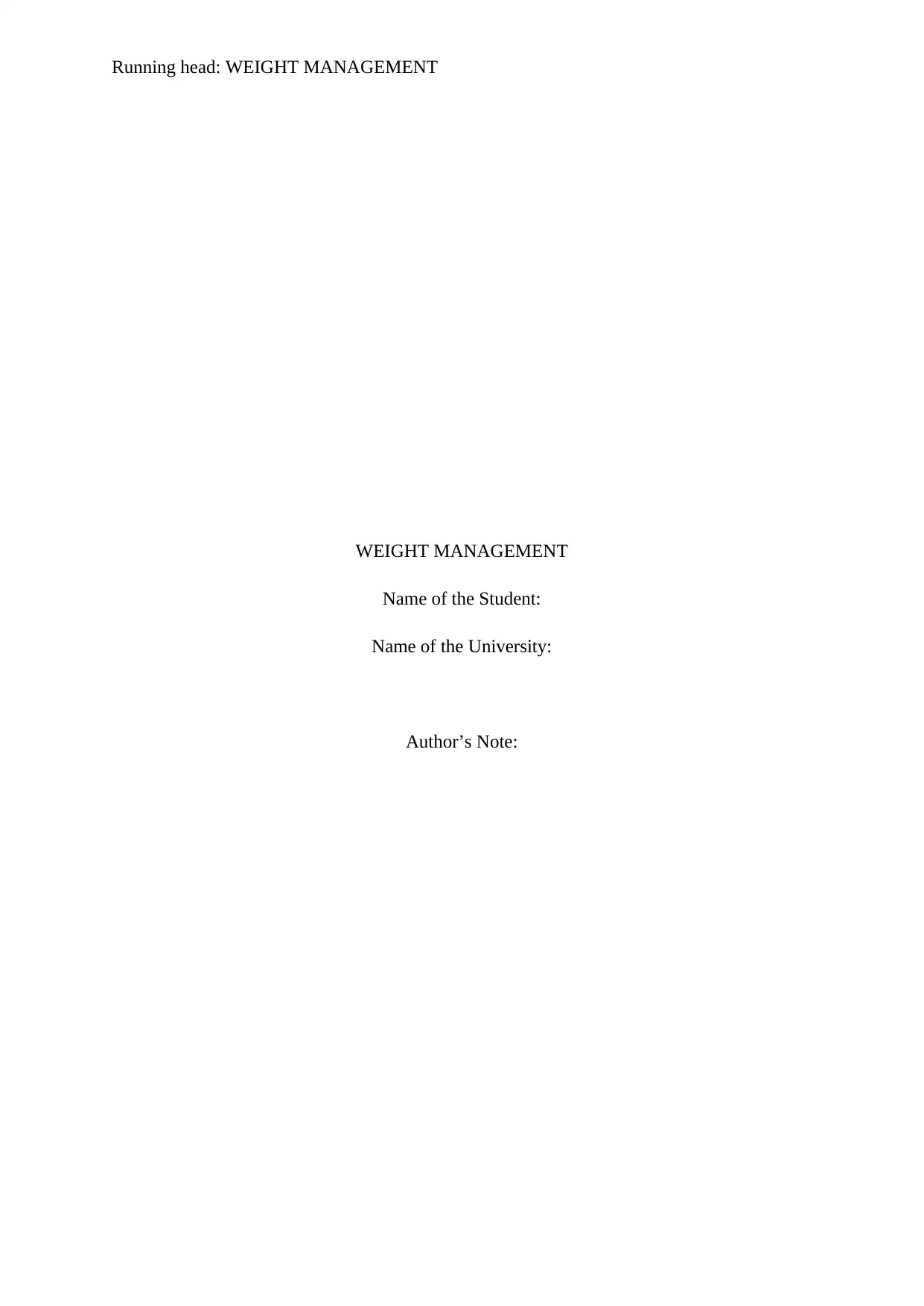
Running head: WEIGHT MANAGEMENT
WEIGHT MANAGEMENT
Name of the Student:
Name of the University:
Author’s Note:
WEIGHT MANAGEMENT
Name of the Student:
Name of the University:
Author’s Note:
Paraphrase This Document
Need a fresh take? Get an instant paraphrase of this document with our AI Paraphraser

1WEIGHT MANAGEMENT
Table of Contents
1. Identifying and discussing causes of obesity in Dave............................................................2
2. Estimating daily energy requirements of Dave......................................................................3
Harris-Benedict equation:......................................................................................................3
Schofield equation:.................................................................................................................3
Henry equation:......................................................................................................................3
FAO equation:........................................................................................................................4
WHO equation:......................................................................................................................4
3. Outlining and evaluating weight management program........................................................5
4. Identifying barriers faced during intervention.......................................................................5
5. Identifying and discussing strategies to minimise deterioration............................................6
6b. Rationale on patient communication design........................................................................7
References..................................................................................................................................8
Table of Contents
1. Identifying and discussing causes of obesity in Dave............................................................2
2. Estimating daily energy requirements of Dave......................................................................3
Harris-Benedict equation:......................................................................................................3
Schofield equation:.................................................................................................................3
Henry equation:......................................................................................................................3
FAO equation:........................................................................................................................4
WHO equation:......................................................................................................................4
3. Outlining and evaluating weight management program........................................................5
4. Identifying barriers faced during intervention.......................................................................5
5. Identifying and discussing strategies to minimise deterioration............................................6
6b. Rationale on patient communication design........................................................................7
References..................................................................................................................................8
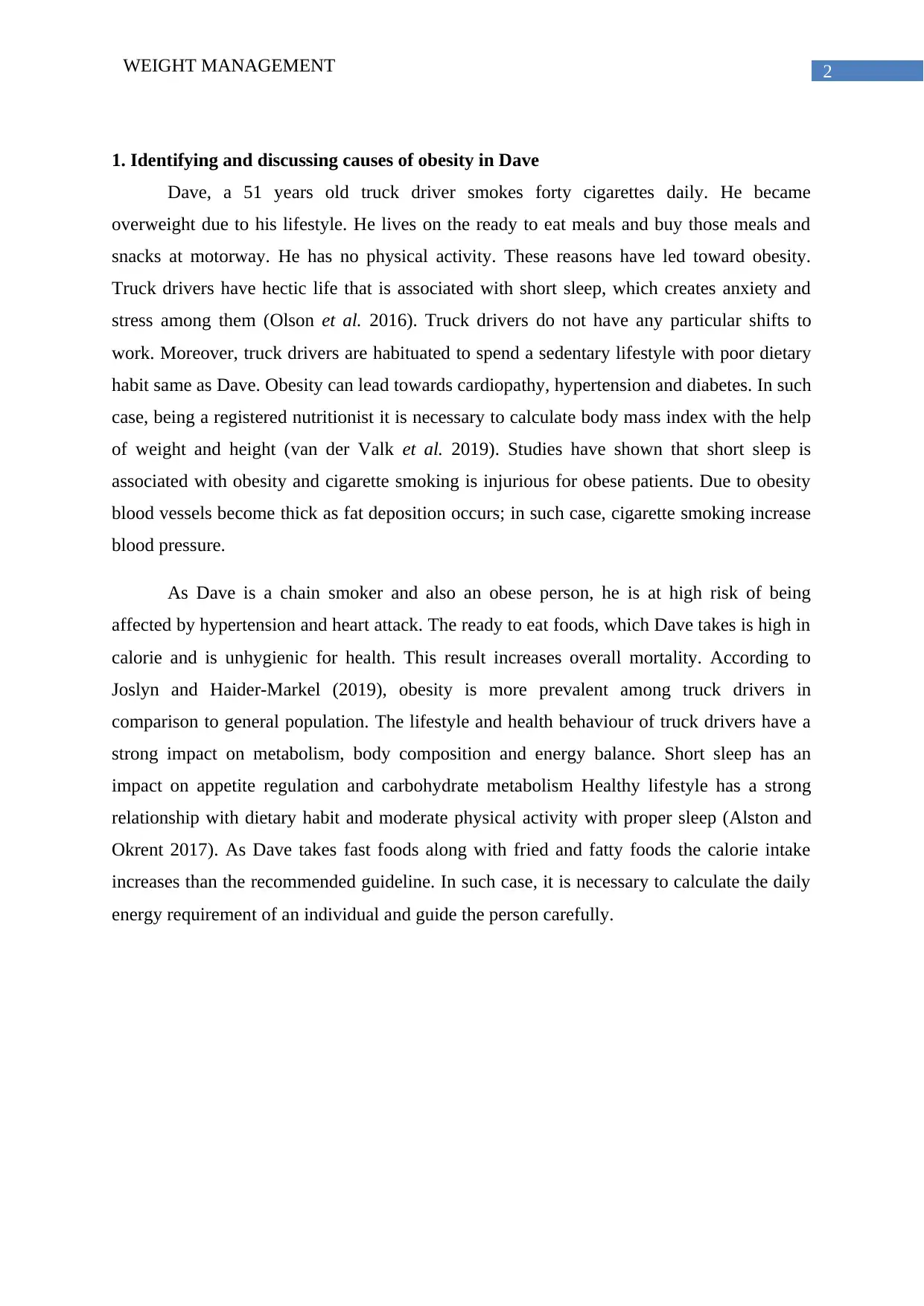
2WEIGHT MANAGEMENT
1. Identifying and discussing causes of obesity in Dave
Dave, a 51 years old truck driver smokes forty cigarettes daily. He became
overweight due to his lifestyle. He lives on the ready to eat meals and buy those meals and
snacks at motorway. He has no physical activity. These reasons have led toward obesity.
Truck drivers have hectic life that is associated with short sleep, which creates anxiety and
stress among them (Olson et al. 2016). Truck drivers do not have any particular shifts to
work. Moreover, truck drivers are habituated to spend a sedentary lifestyle with poor dietary
habit same as Dave. Obesity can lead towards cardiopathy, hypertension and diabetes. In such
case, being a registered nutritionist it is necessary to calculate body mass index with the help
of weight and height (van der Valk et al. 2019). Studies have shown that short sleep is
associated with obesity and cigarette smoking is injurious for obese patients. Due to obesity
blood vessels become thick as fat deposition occurs; in such case, cigarette smoking increase
blood pressure.
As Dave is a chain smoker and also an obese person, he is at high risk of being
affected by hypertension and heart attack. The ready to eat foods, which Dave takes is high in
calorie and is unhygienic for health. This result increases overall mortality. According to
Joslyn and Haider-Markel (2019), obesity is more prevalent among truck drivers in
comparison to general population. The lifestyle and health behaviour of truck drivers have a
strong impact on metabolism, body composition and energy balance. Short sleep has an
impact on appetite regulation and carbohydrate metabolism Healthy lifestyle has a strong
relationship with dietary habit and moderate physical activity with proper sleep (Alston and
Okrent 2017). As Dave takes fast foods along with fried and fatty foods the calorie intake
increases than the recommended guideline. In such case, it is necessary to calculate the daily
energy requirement of an individual and guide the person carefully.
1. Identifying and discussing causes of obesity in Dave
Dave, a 51 years old truck driver smokes forty cigarettes daily. He became
overweight due to his lifestyle. He lives on the ready to eat meals and buy those meals and
snacks at motorway. He has no physical activity. These reasons have led toward obesity.
Truck drivers have hectic life that is associated with short sleep, which creates anxiety and
stress among them (Olson et al. 2016). Truck drivers do not have any particular shifts to
work. Moreover, truck drivers are habituated to spend a sedentary lifestyle with poor dietary
habit same as Dave. Obesity can lead towards cardiopathy, hypertension and diabetes. In such
case, being a registered nutritionist it is necessary to calculate body mass index with the help
of weight and height (van der Valk et al. 2019). Studies have shown that short sleep is
associated with obesity and cigarette smoking is injurious for obese patients. Due to obesity
blood vessels become thick as fat deposition occurs; in such case, cigarette smoking increase
blood pressure.
As Dave is a chain smoker and also an obese person, he is at high risk of being
affected by hypertension and heart attack. The ready to eat foods, which Dave takes is high in
calorie and is unhygienic for health. This result increases overall mortality. According to
Joslyn and Haider-Markel (2019), obesity is more prevalent among truck drivers in
comparison to general population. The lifestyle and health behaviour of truck drivers have a
strong impact on metabolism, body composition and energy balance. Short sleep has an
impact on appetite regulation and carbohydrate metabolism Healthy lifestyle has a strong
relationship with dietary habit and moderate physical activity with proper sleep (Alston and
Okrent 2017). As Dave takes fast foods along with fried and fatty foods the calorie intake
increases than the recommended guideline. In such case, it is necessary to calculate the daily
energy requirement of an individual and guide the person carefully.
⊘ This is a preview!⊘
Do you want full access?
Subscribe today to unlock all pages.

Trusted by 1+ million students worldwide

3WEIGHT MANAGEMENT
2. Estimating daily energy requirements of Dave
Harris-Benedict equation:
BMR = 66+ (6.23*weight in pound) + (12.7*height in inches)-(6.8*ages in years) kcal/day
=66+ (6.23*242.50) + (12.7*68.11)-(6.8*51)
=2103 kcal/day
According to the equation BMR of Dave is 2103 Kcal/day. Determining daily needs
of calorie, it is necessary to multiply proper activity factors with BMR. As the care seeker has
sedentary lifestyle; hence, the result is as follows:
Sedentary: Calorie-calculation
= (BMR* 1.3) calories
= (2103*1.3
= 2734 calories
Schofield equation:
BMR = 11.472*(wt kg) +873.1 kcal/day
= 2135 kcal/day (+/- 167 kcal)
According to the equation, BMR is 2135kcal/day. Hence, total energy requirement
TER = (BMI*1.3) calories
= 2135*1.3
= 2776 calories
Henry equation:
BMR= 14.2* (weight in kg) +593 kcal/day
=14.2* 110+ 593
=2155 kcal/day
As per the equation, BMR is 2155 kcal/day. Hence, total energy requirement of a day
2. Estimating daily energy requirements of Dave
Harris-Benedict equation:
BMR = 66+ (6.23*weight in pound) + (12.7*height in inches)-(6.8*ages in years) kcal/day
=66+ (6.23*242.50) + (12.7*68.11)-(6.8*51)
=2103 kcal/day
According to the equation BMR of Dave is 2103 Kcal/day. Determining daily needs
of calorie, it is necessary to multiply proper activity factors with BMR. As the care seeker has
sedentary lifestyle; hence, the result is as follows:
Sedentary: Calorie-calculation
= (BMR* 1.3) calories
= (2103*1.3
= 2734 calories
Schofield equation:
BMR = 11.472*(wt kg) +873.1 kcal/day
= 2135 kcal/day (+/- 167 kcal)
According to the equation, BMR is 2135kcal/day. Hence, total energy requirement
TER = (BMI*1.3) calories
= 2135*1.3
= 2776 calories
Henry equation:
BMR= 14.2* (weight in kg) +593 kcal/day
=14.2* 110+ 593
=2155 kcal/day
As per the equation, BMR is 2155 kcal/day. Hence, total energy requirement of a day
Paraphrase This Document
Need a fresh take? Get an instant paraphrase of this document with our AI Paraphraser

4WEIGHT MANAGEMENT
TER = (2155*1.3) calories
= 2802 calories
FAO equation:
BMR= 0.048*(wt in kg) +3.653 MJ/day
= 8.93 MJ/day
PAL= 1.2
As per the FAO equation, BMR is 8.93 MJ/day and PAL is 1.2. Hence, the total
energy needs of a day:
TER= (8.93*1.3) MJ/day
= 2775calories
WHO equation:
WHO has recommended that to understand the daily requirement of energy of an
individual, it is necessary to understand the Basal Energy Expenditure of the individual. BEE
is the amount of total requirement of energy of an individual.
TEE= 864- 9.72*age (years) +PA*[(14.2*weight (kg) +503*height (meters)]
=864-9.72*51+1*[(14.2*110+503*1.73)]
= 2800 calories
All of the mentioned formulas have shown different results. According to the formula,
the care seeker is obese and is prone to high risk of different diseases like high blood sugar,
diabetes, hypertension, arthritis and cardiac problem or stroke. However, among all the
results, Harris-Benedict equation is more appropriate and most of the nutritionists use it as
the tool to understand whether the patient is obese or not and it become easier to evaluate the
weight management program for the patient (Massarini et al. 2018). In case of Dave, as per
the result, his BMR is 2103 kcal/day and he needs 2734 calories/day in his diet. From results
it is seen that all of these do not differ much from each other. As mentioned by Luy and
Dampil (2018), a patient can take +/- 50 to 100 calories/day in diet. Hence, it can be said that
all of the results accurate as per the formulas.
TER = (2155*1.3) calories
= 2802 calories
FAO equation:
BMR= 0.048*(wt in kg) +3.653 MJ/day
= 8.93 MJ/day
PAL= 1.2
As per the FAO equation, BMR is 8.93 MJ/day and PAL is 1.2. Hence, the total
energy needs of a day:
TER= (8.93*1.3) MJ/day
= 2775calories
WHO equation:
WHO has recommended that to understand the daily requirement of energy of an
individual, it is necessary to understand the Basal Energy Expenditure of the individual. BEE
is the amount of total requirement of energy of an individual.
TEE= 864- 9.72*age (years) +PA*[(14.2*weight (kg) +503*height (meters)]
=864-9.72*51+1*[(14.2*110+503*1.73)]
= 2800 calories
All of the mentioned formulas have shown different results. According to the formula,
the care seeker is obese and is prone to high risk of different diseases like high blood sugar,
diabetes, hypertension, arthritis and cardiac problem or stroke. However, among all the
results, Harris-Benedict equation is more appropriate and most of the nutritionists use it as
the tool to understand whether the patient is obese or not and it become easier to evaluate the
weight management program for the patient (Massarini et al. 2018). In case of Dave, as per
the result, his BMR is 2103 kcal/day and he needs 2734 calories/day in his diet. From results
it is seen that all of these do not differ much from each other. As mentioned by Luy and
Dampil (2018), a patient can take +/- 50 to 100 calories/day in diet. Hence, it can be said that
all of the results accurate as per the formulas.
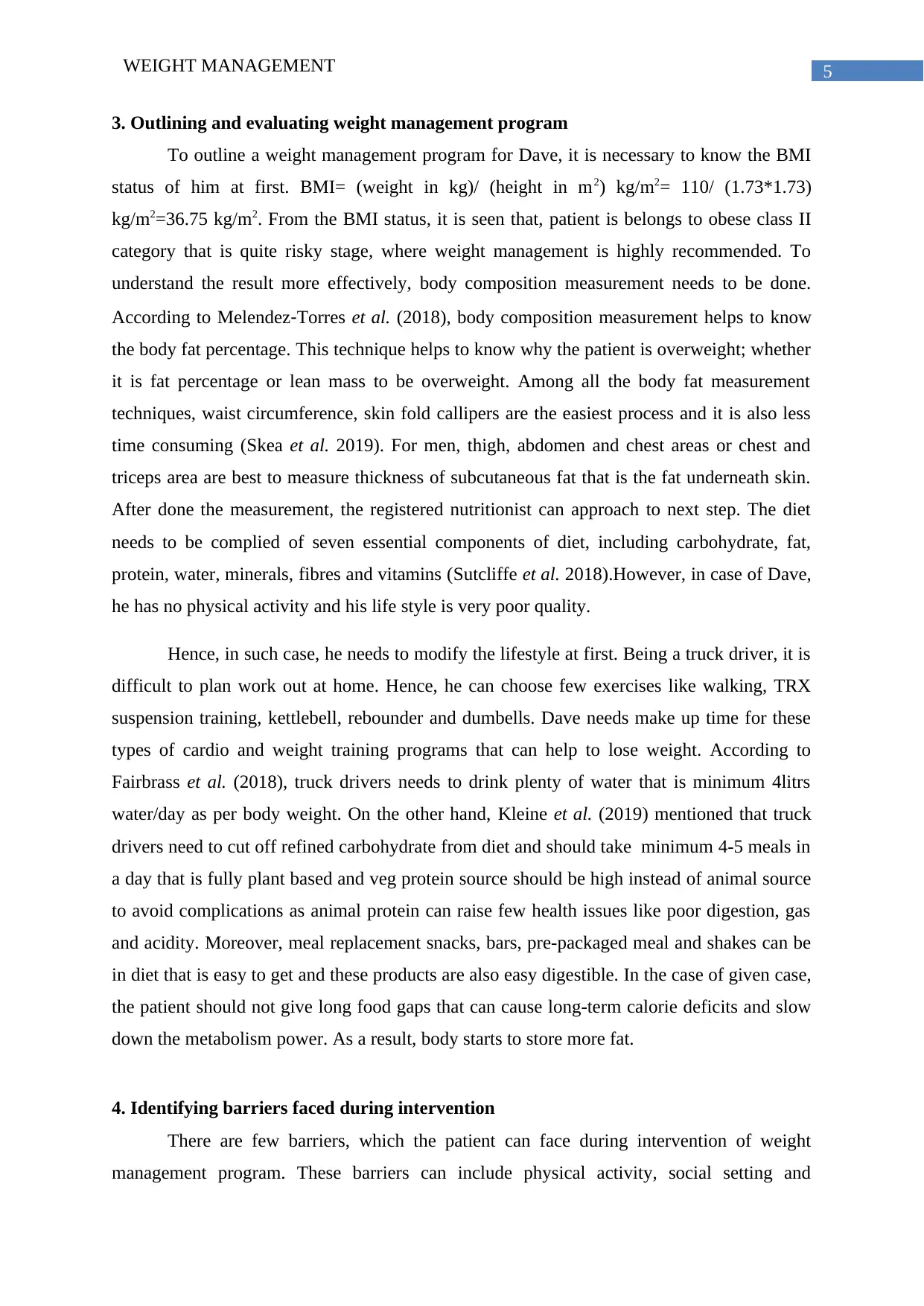
5WEIGHT MANAGEMENT
3. Outlining and evaluating weight management program
To outline a weight management program for Dave, it is necessary to know the BMI
status of him at first. BMI= (weight in kg)/ (height in m2) kg/m2= 110/ (1.73*1.73)
kg/m2=36.75 kg/m2. From the BMI status, it is seen that, patient is belongs to obese class II
category that is quite risky stage, where weight management is highly recommended. To
understand the result more effectively, body composition measurement needs to be done.
According to Melendez‐Torres et al. (2018), body composition measurement helps to know
the body fat percentage. This technique helps to know why the patient is overweight; whether
it is fat percentage or lean mass to be overweight. Among all the body fat measurement
techniques, waist circumference, skin fold callipers are the easiest process and it is also less
time consuming (Skea et al. 2019). For men, thigh, abdomen and chest areas or chest and
triceps area are best to measure thickness of subcutaneous fat that is the fat underneath skin.
After done the measurement, the registered nutritionist can approach to next step. The diet
needs to be complied of seven essential components of diet, including carbohydrate, fat,
protein, water, minerals, fibres and vitamins (Sutcliffe et al. 2018).However, in case of Dave,
he has no physical activity and his life style is very poor quality.
Hence, in such case, he needs to modify the lifestyle at first. Being a truck driver, it is
difficult to plan work out at home. Hence, he can choose few exercises like walking, TRX
suspension training, kettlebell, rebounder and dumbells. Dave needs make up time for these
types of cardio and weight training programs that can help to lose weight. According to
Fairbrass et al. (2018), truck drivers needs to drink plenty of water that is minimum 4litrs
water/day as per body weight. On the other hand, Kleine et al. (2019) mentioned that truck
drivers need to cut off refined carbohydrate from diet and should take minimum 4-5 meals in
a day that is fully plant based and veg protein source should be high instead of animal source
to avoid complications as animal protein can raise few health issues like poor digestion, gas
and acidity. Moreover, meal replacement snacks, bars, pre-packaged meal and shakes can be
in diet that is easy to get and these products are also easy digestible. In the case of given case,
the patient should not give long food gaps that can cause long-term calorie deficits and slow
down the metabolism power. As a result, body starts to store more fat.
4. Identifying barriers faced during intervention
There are few barriers, which the patient can face during intervention of weight
management program. These barriers can include physical activity, social setting and
3. Outlining and evaluating weight management program
To outline a weight management program for Dave, it is necessary to know the BMI
status of him at first. BMI= (weight in kg)/ (height in m2) kg/m2= 110/ (1.73*1.73)
kg/m2=36.75 kg/m2. From the BMI status, it is seen that, patient is belongs to obese class II
category that is quite risky stage, where weight management is highly recommended. To
understand the result more effectively, body composition measurement needs to be done.
According to Melendez‐Torres et al. (2018), body composition measurement helps to know
the body fat percentage. This technique helps to know why the patient is overweight; whether
it is fat percentage or lean mass to be overweight. Among all the body fat measurement
techniques, waist circumference, skin fold callipers are the easiest process and it is also less
time consuming (Skea et al. 2019). For men, thigh, abdomen and chest areas or chest and
triceps area are best to measure thickness of subcutaneous fat that is the fat underneath skin.
After done the measurement, the registered nutritionist can approach to next step. The diet
needs to be complied of seven essential components of diet, including carbohydrate, fat,
protein, water, minerals, fibres and vitamins (Sutcliffe et al. 2018).However, in case of Dave,
he has no physical activity and his life style is very poor quality.
Hence, in such case, he needs to modify the lifestyle at first. Being a truck driver, it is
difficult to plan work out at home. Hence, he can choose few exercises like walking, TRX
suspension training, kettlebell, rebounder and dumbells. Dave needs make up time for these
types of cardio and weight training programs that can help to lose weight. According to
Fairbrass et al. (2018), truck drivers needs to drink plenty of water that is minimum 4litrs
water/day as per body weight. On the other hand, Kleine et al. (2019) mentioned that truck
drivers need to cut off refined carbohydrate from diet and should take minimum 4-5 meals in
a day that is fully plant based and veg protein source should be high instead of animal source
to avoid complications as animal protein can raise few health issues like poor digestion, gas
and acidity. Moreover, meal replacement snacks, bars, pre-packaged meal and shakes can be
in diet that is easy to get and these products are also easy digestible. In the case of given case,
the patient should not give long food gaps that can cause long-term calorie deficits and slow
down the metabolism power. As a result, body starts to store more fat.
4. Identifying barriers faced during intervention
There are few barriers, which the patient can face during intervention of weight
management program. These barriers can include physical activity, social setting and
⊘ This is a preview!⊘
Do you want full access?
Subscribe today to unlock all pages.

Trusted by 1+ million students worldwide
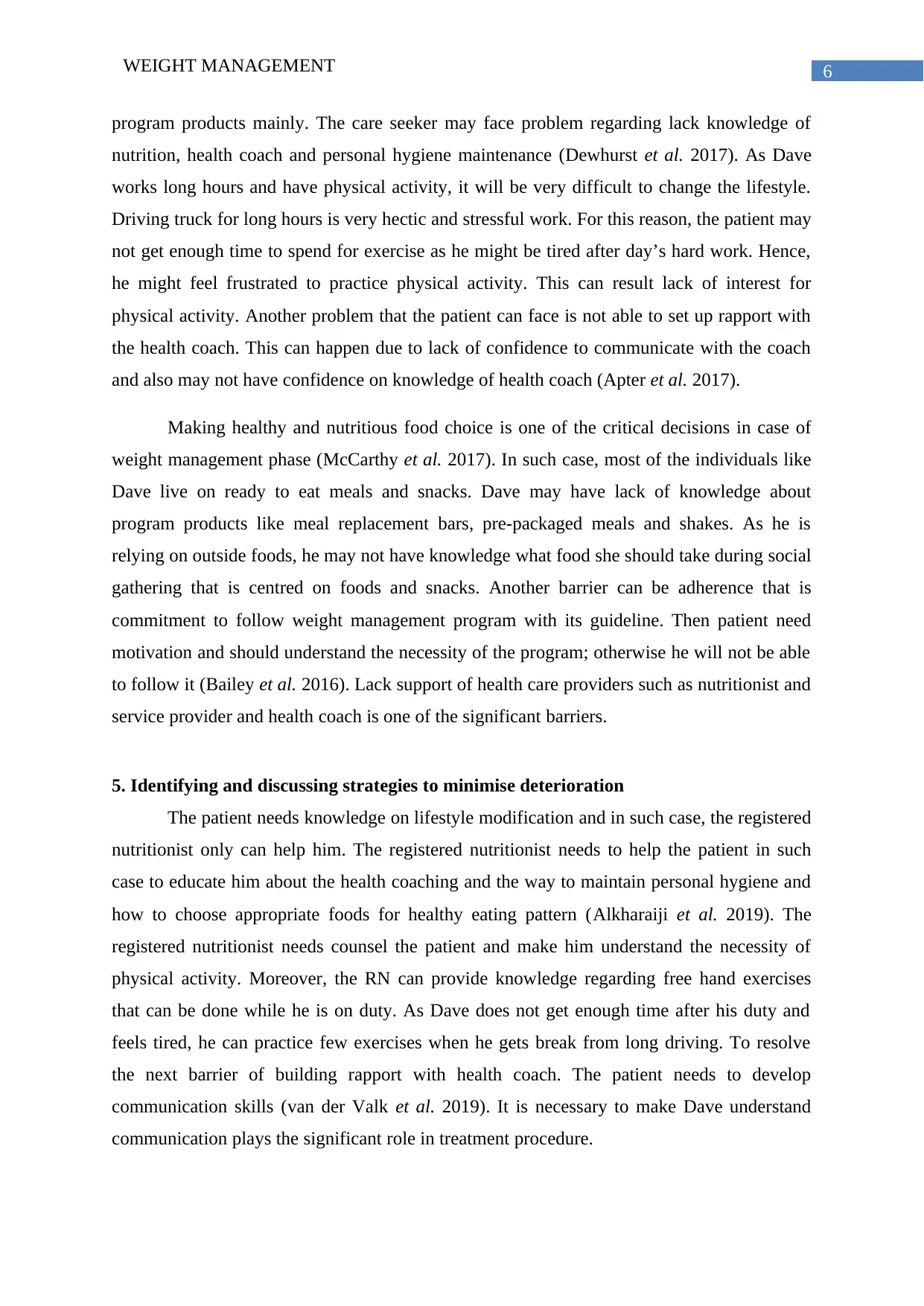
6WEIGHT MANAGEMENT
program products mainly. The care seeker may face problem regarding lack knowledge of
nutrition, health coach and personal hygiene maintenance (Dewhurst et al. 2017). As Dave
works long hours and have physical activity, it will be very difficult to change the lifestyle.
Driving truck for long hours is very hectic and stressful work. For this reason, the patient may
not get enough time to spend for exercise as he might be tired after day’s hard work. Hence,
he might feel frustrated to practice physical activity. This can result lack of interest for
physical activity. Another problem that the patient can face is not able to set up rapport with
the health coach. This can happen due to lack of confidence to communicate with the coach
and also may not have confidence on knowledge of health coach (Apter et al. 2017).
Making healthy and nutritious food choice is one of the critical decisions in case of
weight management phase (McCarthy et al. 2017). In such case, most of the individuals like
Dave live on ready to eat meals and snacks. Dave may have lack of knowledge about
program products like meal replacement bars, pre-packaged meals and shakes. As he is
relying on outside foods, he may not have knowledge what food she should take during social
gathering that is centred on foods and snacks. Another barrier can be adherence that is
commitment to follow weight management program with its guideline. Then patient need
motivation and should understand the necessity of the program; otherwise he will not be able
to follow it (Bailey et al. 2016). Lack support of health care providers such as nutritionist and
service provider and health coach is one of the significant barriers.
5. Identifying and discussing strategies to minimise deterioration
The patient needs knowledge on lifestyle modification and in such case, the registered
nutritionist only can help him. The registered nutritionist needs to help the patient in such
case to educate him about the health coaching and the way to maintain personal hygiene and
how to choose appropriate foods for healthy eating pattern (Alkharaiji et al. 2019). The
registered nutritionist needs counsel the patient and make him understand the necessity of
physical activity. Moreover, the RN can provide knowledge regarding free hand exercises
that can be done while he is on duty. As Dave does not get enough time after his duty and
feels tired, he can practice few exercises when he gets break from long driving. To resolve
the next barrier of building rapport with health coach. The patient needs to develop
communication skills (van der Valk et al. 2019). It is necessary to make Dave understand
communication plays the significant role in treatment procedure.
program products mainly. The care seeker may face problem regarding lack knowledge of
nutrition, health coach and personal hygiene maintenance (Dewhurst et al. 2017). As Dave
works long hours and have physical activity, it will be very difficult to change the lifestyle.
Driving truck for long hours is very hectic and stressful work. For this reason, the patient may
not get enough time to spend for exercise as he might be tired after day’s hard work. Hence,
he might feel frustrated to practice physical activity. This can result lack of interest for
physical activity. Another problem that the patient can face is not able to set up rapport with
the health coach. This can happen due to lack of confidence to communicate with the coach
and also may not have confidence on knowledge of health coach (Apter et al. 2017).
Making healthy and nutritious food choice is one of the critical decisions in case of
weight management phase (McCarthy et al. 2017). In such case, most of the individuals like
Dave live on ready to eat meals and snacks. Dave may have lack of knowledge about
program products like meal replacement bars, pre-packaged meals and shakes. As he is
relying on outside foods, he may not have knowledge what food she should take during social
gathering that is centred on foods and snacks. Another barrier can be adherence that is
commitment to follow weight management program with its guideline. Then patient need
motivation and should understand the necessity of the program; otherwise he will not be able
to follow it (Bailey et al. 2016). Lack support of health care providers such as nutritionist and
service provider and health coach is one of the significant barriers.
5. Identifying and discussing strategies to minimise deterioration
The patient needs knowledge on lifestyle modification and in such case, the registered
nutritionist only can help him. The registered nutritionist needs to help the patient in such
case to educate him about the health coaching and the way to maintain personal hygiene and
how to choose appropriate foods for healthy eating pattern (Alkharaiji et al. 2019). The
registered nutritionist needs counsel the patient and make him understand the necessity of
physical activity. Moreover, the RN can provide knowledge regarding free hand exercises
that can be done while he is on duty. As Dave does not get enough time after his duty and
feels tired, he can practice few exercises when he gets break from long driving. To resolve
the next barrier of building rapport with health coach. The patient needs to develop
communication skills (van der Valk et al. 2019). It is necessary to make Dave understand
communication plays the significant role in treatment procedure.
Paraphrase This Document
Need a fresh take? Get an instant paraphrase of this document with our AI Paraphraser
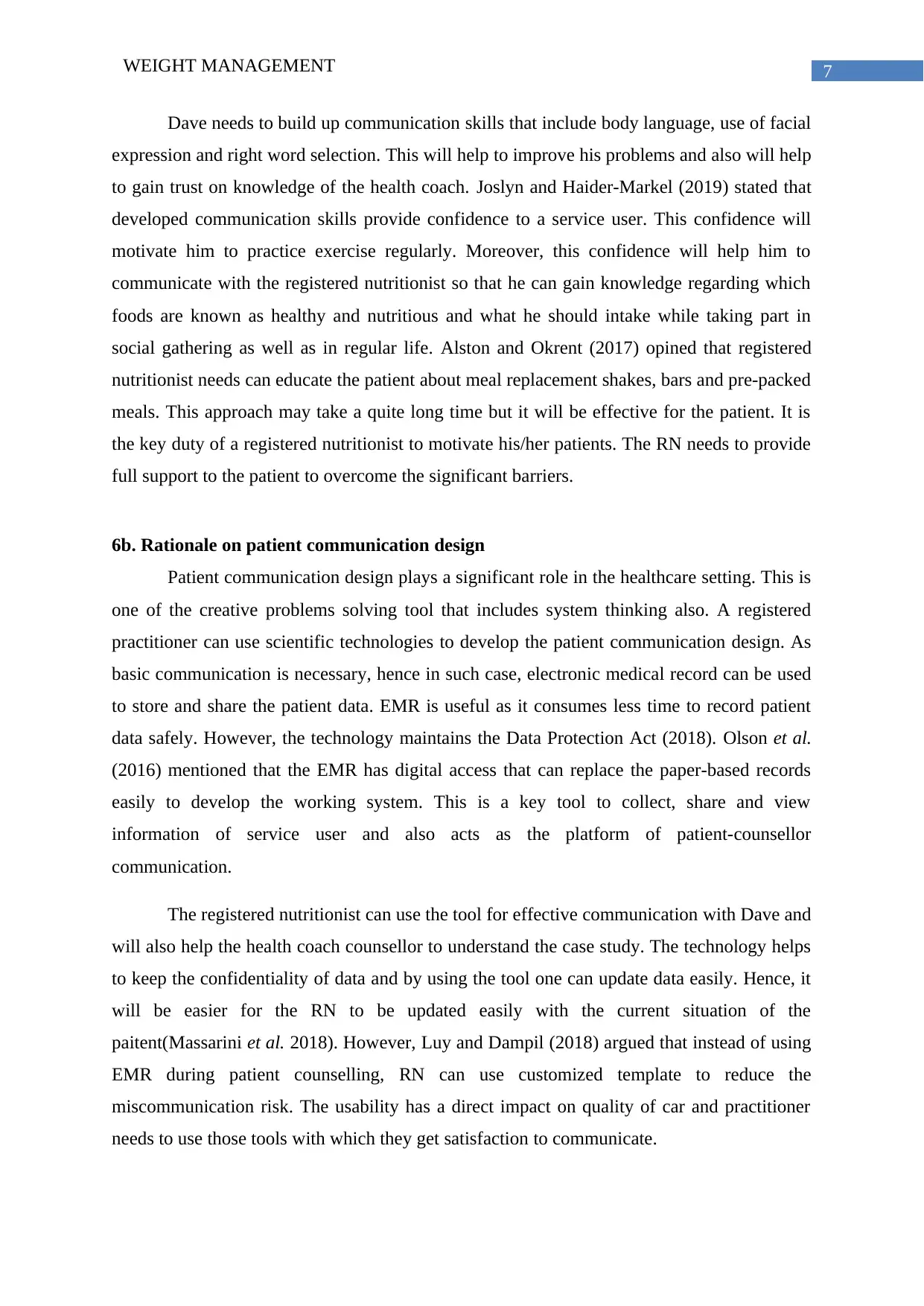
7WEIGHT MANAGEMENT
Dave needs to build up communication skills that include body language, use of facial
expression and right word selection. This will help to improve his problems and also will help
to gain trust on knowledge of the health coach. Joslyn and Haider-Markel (2019) stated that
developed communication skills provide confidence to a service user. This confidence will
motivate him to practice exercise regularly. Moreover, this confidence will help him to
communicate with the registered nutritionist so that he can gain knowledge regarding which
foods are known as healthy and nutritious and what he should intake while taking part in
social gathering as well as in regular life. Alston and Okrent (2017) opined that registered
nutritionist needs can educate the patient about meal replacement shakes, bars and pre-packed
meals. This approach may take a quite long time but it will be effective for the patient. It is
the key duty of a registered nutritionist to motivate his/her patients. The RN needs to provide
full support to the patient to overcome the significant barriers.
6b. Rationale on patient communication design
Patient communication design plays a significant role in the healthcare setting. This is
one of the creative problems solving tool that includes system thinking also. A registered
practitioner can use scientific technologies to develop the patient communication design. As
basic communication is necessary, hence in such case, electronic medical record can be used
to store and share the patient data. EMR is useful as it consumes less time to record patient
data safely. However, the technology maintains the Data Protection Act (2018). Olson et al.
(2016) mentioned that the EMR has digital access that can replace the paper-based records
easily to develop the working system. This is a key tool to collect, share and view
information of service user and also acts as the platform of patient-counsellor
communication.
The registered nutritionist can use the tool for effective communication with Dave and
will also help the health coach counsellor to understand the case study. The technology helps
to keep the confidentiality of data and by using the tool one can update data easily. Hence, it
will be easier for the RN to be updated easily with the current situation of the
paitent(Massarini et al. 2018). However, Luy and Dampil (2018) argued that instead of using
EMR during patient counselling, RN can use customized template to reduce the
miscommunication risk. The usability has a direct impact on quality of car and practitioner
needs to use those tools with which they get satisfaction to communicate.
Dave needs to build up communication skills that include body language, use of facial
expression and right word selection. This will help to improve his problems and also will help
to gain trust on knowledge of the health coach. Joslyn and Haider-Markel (2019) stated that
developed communication skills provide confidence to a service user. This confidence will
motivate him to practice exercise regularly. Moreover, this confidence will help him to
communicate with the registered nutritionist so that he can gain knowledge regarding which
foods are known as healthy and nutritious and what he should intake while taking part in
social gathering as well as in regular life. Alston and Okrent (2017) opined that registered
nutritionist needs can educate the patient about meal replacement shakes, bars and pre-packed
meals. This approach may take a quite long time but it will be effective for the patient. It is
the key duty of a registered nutritionist to motivate his/her patients. The RN needs to provide
full support to the patient to overcome the significant barriers.
6b. Rationale on patient communication design
Patient communication design plays a significant role in the healthcare setting. This is
one of the creative problems solving tool that includes system thinking also. A registered
practitioner can use scientific technologies to develop the patient communication design. As
basic communication is necessary, hence in such case, electronic medical record can be used
to store and share the patient data. EMR is useful as it consumes less time to record patient
data safely. However, the technology maintains the Data Protection Act (2018). Olson et al.
(2016) mentioned that the EMR has digital access that can replace the paper-based records
easily to develop the working system. This is a key tool to collect, share and view
information of service user and also acts as the platform of patient-counsellor
communication.
The registered nutritionist can use the tool for effective communication with Dave and
will also help the health coach counsellor to understand the case study. The technology helps
to keep the confidentiality of data and by using the tool one can update data easily. Hence, it
will be easier for the RN to be updated easily with the current situation of the
paitent(Massarini et al. 2018). However, Luy and Dampil (2018) argued that instead of using
EMR during patient counselling, RN can use customized template to reduce the
miscommunication risk. The usability has a direct impact on quality of car and practitioner
needs to use those tools with which they get satisfaction to communicate.

8WEIGHT MANAGEMENT
References
Alkharaiji, M., Anyanwagu, U., Donnelly, R. and Idris, I., 2019. Tier 3 specialist weight
management service and pre‐bariatric multicomponent weight management programmes for
adults with obesity living in the UK: A systematic review. Endocrinology, diabetes &
metabolism, 2(1), p.e00042.
Alston, J.M. and Okrent, A.M., 2017. Causes of Obesity: External Influences. In The Effects
of Farm and Food Policy on Obesity in the United States (pp. 105-134). Palgrave Macmillan,
New York.
Apter, A.J., Morales, K.H., Han, X., Perez, L., Huang, J., Ndicu, G., Localio, A., Nardi, A.,
Klusaritz, H., Rogers, M. and Phillips, A., 2017. A patient advocate to facilitate access and
improve communication, care, and outcomes in adults with moderate or severe asthma:
Rationale, design, and methods of a randomized controlled trial. Contemporary clinical
trials, 56, pp.34-45.
Bailey, S.C., Paasche-Orlow, M.K., Adams, W.G., Brokenshire, S.A., Hickson, R.P.,
Oramasionwu, C.U., Curtis, L.M., Kwasny, M.J. and Wolf, M.S., 2016. The electronic
medication complete communication (EMC2) study: Rationale and methods for a randomized
controlled trial of a strategy to promote medication safety in ambulatory care. Contemporary
clinical trials, 51, pp.72-77.
Dewhurst, A., Peters, S., Devereux-Fitzgerald, A. and Hart, J., 2017. Physicians’ views and
experiences of discussing weight management within routine clinical consultations: a
thematic synthesis. Patient education and counseling, 100(5), pp.897-908.
Fairbrass, K., Martin, S. and Moreea, S., 2018. PTU-091 A review of specialist hepatology
dietetics service; limitations of weight management programmes observing nice guidance.
Joslyn, M.R. and Haider-Markel, D.P., 2019. Perceived causes of obesity, emotions, and
attitudes about Discrimination Policy. Social Science & Medicine, 223, pp.97-103.
Kleine, H.D., McCormack, L.A., Drooger, A. and Meendering, J.R., 2019. Barriers to and
facilitators of weight management in adults using a meal replacement program that includes
health coaching. Journal of primary care & community health, 10, p.2150132719851643.
References
Alkharaiji, M., Anyanwagu, U., Donnelly, R. and Idris, I., 2019. Tier 3 specialist weight
management service and pre‐bariatric multicomponent weight management programmes for
adults with obesity living in the UK: A systematic review. Endocrinology, diabetes &
metabolism, 2(1), p.e00042.
Alston, J.M. and Okrent, A.M., 2017. Causes of Obesity: External Influences. In The Effects
of Farm and Food Policy on Obesity in the United States (pp. 105-134). Palgrave Macmillan,
New York.
Apter, A.J., Morales, K.H., Han, X., Perez, L., Huang, J., Ndicu, G., Localio, A., Nardi, A.,
Klusaritz, H., Rogers, M. and Phillips, A., 2017. A patient advocate to facilitate access and
improve communication, care, and outcomes in adults with moderate or severe asthma:
Rationale, design, and methods of a randomized controlled trial. Contemporary clinical
trials, 56, pp.34-45.
Bailey, S.C., Paasche-Orlow, M.K., Adams, W.G., Brokenshire, S.A., Hickson, R.P.,
Oramasionwu, C.U., Curtis, L.M., Kwasny, M.J. and Wolf, M.S., 2016. The electronic
medication complete communication (EMC2) study: Rationale and methods for a randomized
controlled trial of a strategy to promote medication safety in ambulatory care. Contemporary
clinical trials, 51, pp.72-77.
Dewhurst, A., Peters, S., Devereux-Fitzgerald, A. and Hart, J., 2017. Physicians’ views and
experiences of discussing weight management within routine clinical consultations: a
thematic synthesis. Patient education and counseling, 100(5), pp.897-908.
Fairbrass, K., Martin, S. and Moreea, S., 2018. PTU-091 A review of specialist hepatology
dietetics service; limitations of weight management programmes observing nice guidance.
Joslyn, M.R. and Haider-Markel, D.P., 2019. Perceived causes of obesity, emotions, and
attitudes about Discrimination Policy. Social Science & Medicine, 223, pp.97-103.
Kleine, H.D., McCormack, L.A., Drooger, A. and Meendering, J.R., 2019. Barriers to and
facilitators of weight management in adults using a meal replacement program that includes
health coaching. Journal of primary care & community health, 10, p.2150132719851643.
⊘ This is a preview!⊘
Do you want full access?
Subscribe today to unlock all pages.

Trusted by 1+ million students worldwide
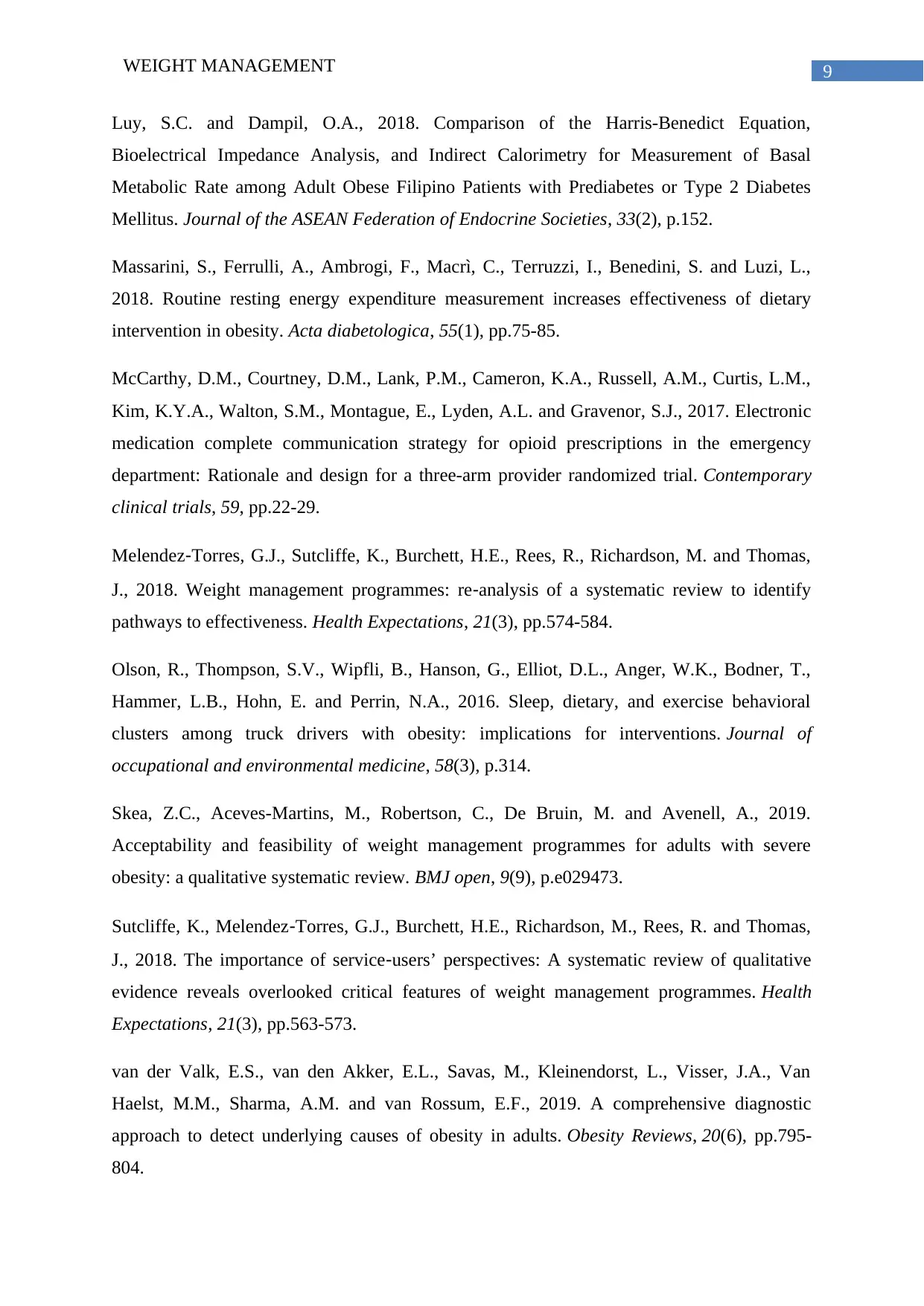
9WEIGHT MANAGEMENT
Luy, S.C. and Dampil, O.A., 2018. Comparison of the Harris-Benedict Equation,
Bioelectrical Impedance Analysis, and Indirect Calorimetry for Measurement of Basal
Metabolic Rate among Adult Obese Filipino Patients with Prediabetes or Type 2 Diabetes
Mellitus. Journal of the ASEAN Federation of Endocrine Societies, 33(2), p.152.
Massarini, S., Ferrulli, A., Ambrogi, F., Macrì, C., Terruzzi, I., Benedini, S. and Luzi, L.,
2018. Routine resting energy expenditure measurement increases effectiveness of dietary
intervention in obesity. Acta diabetologica, 55(1), pp.75-85.
McCarthy, D.M., Courtney, D.M., Lank, P.M., Cameron, K.A., Russell, A.M., Curtis, L.M.,
Kim, K.Y.A., Walton, S.M., Montague, E., Lyden, A.L. and Gravenor, S.J., 2017. Electronic
medication complete communication strategy for opioid prescriptions in the emergency
department: Rationale and design for a three-arm provider randomized trial. Contemporary
clinical trials, 59, pp.22-29.
Melendez‐Torres, G.J., Sutcliffe, K., Burchett, H.E., Rees, R., Richardson, M. and Thomas,
J., 2018. Weight management programmes: re‐analysis of a systematic review to identify
pathways to effectiveness. Health Expectations, 21(3), pp.574-584.
Olson, R., Thompson, S.V., Wipfli, B., Hanson, G., Elliot, D.L., Anger, W.K., Bodner, T.,
Hammer, L.B., Hohn, E. and Perrin, N.A., 2016. Sleep, dietary, and exercise behavioral
clusters among truck drivers with obesity: implications for interventions. Journal of
occupational and environmental medicine, 58(3), p.314.
Skea, Z.C., Aceves-Martins, M., Robertson, C., De Bruin, M. and Avenell, A., 2019.
Acceptability and feasibility of weight management programmes for adults with severe
obesity: a qualitative systematic review. BMJ open, 9(9), p.e029473.
Sutcliffe, K., Melendez‐Torres, G.J., Burchett, H.E., Richardson, M., Rees, R. and Thomas,
J., 2018. The importance of service‐users’ perspectives: A systematic review of qualitative
evidence reveals overlooked critical features of weight management programmes. Health
Expectations, 21(3), pp.563-573.
van der Valk, E.S., van den Akker, E.L., Savas, M., Kleinendorst, L., Visser, J.A., Van
Haelst, M.M., Sharma, A.M. and van Rossum, E.F., 2019. A comprehensive diagnostic
approach to detect underlying causes of obesity in adults. Obesity Reviews, 20(6), pp.795-
804.
Luy, S.C. and Dampil, O.A., 2018. Comparison of the Harris-Benedict Equation,
Bioelectrical Impedance Analysis, and Indirect Calorimetry for Measurement of Basal
Metabolic Rate among Adult Obese Filipino Patients with Prediabetes or Type 2 Diabetes
Mellitus. Journal of the ASEAN Federation of Endocrine Societies, 33(2), p.152.
Massarini, S., Ferrulli, A., Ambrogi, F., Macrì, C., Terruzzi, I., Benedini, S. and Luzi, L.,
2018. Routine resting energy expenditure measurement increases effectiveness of dietary
intervention in obesity. Acta diabetologica, 55(1), pp.75-85.
McCarthy, D.M., Courtney, D.M., Lank, P.M., Cameron, K.A., Russell, A.M., Curtis, L.M.,
Kim, K.Y.A., Walton, S.M., Montague, E., Lyden, A.L. and Gravenor, S.J., 2017. Electronic
medication complete communication strategy for opioid prescriptions in the emergency
department: Rationale and design for a three-arm provider randomized trial. Contemporary
clinical trials, 59, pp.22-29.
Melendez‐Torres, G.J., Sutcliffe, K., Burchett, H.E., Rees, R., Richardson, M. and Thomas,
J., 2018. Weight management programmes: re‐analysis of a systematic review to identify
pathways to effectiveness. Health Expectations, 21(3), pp.574-584.
Olson, R., Thompson, S.V., Wipfli, B., Hanson, G., Elliot, D.L., Anger, W.K., Bodner, T.,
Hammer, L.B., Hohn, E. and Perrin, N.A., 2016. Sleep, dietary, and exercise behavioral
clusters among truck drivers with obesity: implications for interventions. Journal of
occupational and environmental medicine, 58(3), p.314.
Skea, Z.C., Aceves-Martins, M., Robertson, C., De Bruin, M. and Avenell, A., 2019.
Acceptability and feasibility of weight management programmes for adults with severe
obesity: a qualitative systematic review. BMJ open, 9(9), p.e029473.
Sutcliffe, K., Melendez‐Torres, G.J., Burchett, H.E., Richardson, M., Rees, R. and Thomas,
J., 2018. The importance of service‐users’ perspectives: A systematic review of qualitative
evidence reveals overlooked critical features of weight management programmes. Health
Expectations, 21(3), pp.563-573.
van der Valk, E.S., van den Akker, E.L., Savas, M., Kleinendorst, L., Visser, J.A., Van
Haelst, M.M., Sharma, A.M. and van Rossum, E.F., 2019. A comprehensive diagnostic
approach to detect underlying causes of obesity in adults. Obesity Reviews, 20(6), pp.795-
804.
Paraphrase This Document
Need a fresh take? Get an instant paraphrase of this document with our AI Paraphraser

10WEIGHT MANAGEMENT
1 out of 11
Your All-in-One AI-Powered Toolkit for Academic Success.
+13062052269
info@desklib.com
Available 24*7 on WhatsApp / Email
![[object Object]](/_next/static/media/star-bottom.7253800d.svg)
Unlock your academic potential
© 2024 | Zucol Services PVT LTD | All rights reserved.